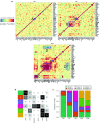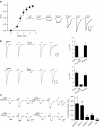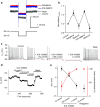Characterizing human stem cell-derived sensory neurons at the single-cell level reveals their ion channel expression and utility in pain research
- PMID: 24832007
- PMCID: PMC4435594
- DOI: 10.1038/mt.2014.86
Characterizing human stem cell-derived sensory neurons at the single-cell level reveals their ion channel expression and utility in pain research
Abstract
The generation of human sensory neurons by directed differentiation of pluripotent stem cells opens new opportunities for investigating the biology of pain. The inability to generate this cell type has meant that up until now their study has been reliant on the use of rodent models. Here, we use a combination of population and single-cell techniques to perform a detailed molecular, electrophysiological, and pharmacological phenotyping of sensory neurons derived from human embryonic stem cells. We describe the evolution of cell populations over 6 weeks of directed differentiation; a process that results in the generation of a largely homogeneous population of neurons that are both molecularly and functionally comparable to human sensory neurons derived from mature dorsal root ganglia. This work opens the prospect of using pluripotent stem-cell-derived sensory neurons to study human neuronal physiology and as in vitro models for drug discovery in pain and sensory disorders.
Figures








Comment in
-
Making sense of pain: are pluripotent stem cell-derived sensory neurons a new tool for studying pain mechanisms?Mol Ther. 2014 Aug;22(8):1403-1405. doi: 10.1038/mt.2014.123. Mol Ther. 2014. PMID: 25082088 Free PMC article. No abstract available.
Similar articles
-
Making sense of pain: are pluripotent stem cell-derived sensory neurons a new tool for studying pain mechanisms?Mol Ther. 2014 Aug;22(8):1403-1405. doi: 10.1038/mt.2014.123. Mol Ther. 2014. PMID: 25082088 Free PMC article. No abstract available.
-
Modelling the dorsal root ganglia using human pluripotent stem cells: A platform to study peripheral neuropathies.Int J Biochem Cell Biol. 2018 Jul;100:61-68. doi: 10.1016/j.biocel.2018.05.005. Epub 2018 Jun 1. Int J Biochem Cell Biol. 2018. PMID: 29772357 Review.
-
Functional up-regulation of Nav1.8 sodium channel on dorsal root ganglia neurons contributes to the induction of scorpion sting pain.Acta Biochim Biophys Sin (Shanghai). 2016 Feb;48(2):132-44. doi: 10.1093/abbs/gmv123. Epub 2016 Jan 12. Acta Biochim Biophys Sin (Shanghai). 2016. PMID: 26764239
-
Electrophysiological Analyses of Human Dorsal Root Ganglia and Human Induced Pluripotent Stem Cell-derived Sensory Neurons From Male and Female Donors.J Pain. 2024 Jun;25(6):104451. doi: 10.1016/j.jpain.2023.12.008. Epub 2023 Dec 27. J Pain. 2024. PMID: 38154622 Free PMC article.
-
Sodium channels and pain.Proc Natl Acad Sci U S A. 1999 Jul 6;96(14):7635-9. doi: 10.1073/pnas.96.14.7635. Proc Natl Acad Sci U S A. 1999. PMID: 10393872 Free PMC article. Review.
Cited by
-
Contributions of NaV1.8 and NaV1.9 to excitability in human induced pluripotent stem-cell derived somatosensory neurons.Sci Rep. 2021 Dec 20;11(1):24283. doi: 10.1038/s41598-021-03608-x. Sci Rep. 2021. PMID: 34930944 Free PMC article.
-
The role of Nav1.7 in human nociceptors: insights from human induced pluripotent stem cell-derived sensory neurons of erythromelalgia patients.Pain. 2019 Jun;160(6):1327-1341. doi: 10.1097/j.pain.0000000000001511. Pain. 2019. PMID: 30720580 Free PMC article.
-
Screening of candidate analgesics using a patient-derived human iPSC model of nociception identifies putative compounds for therapeutic treatment.Clin Transl Med. 2025 May;15(5):e70339. doi: 10.1002/ctm2.70339. Clin Transl Med. 2025. PMID: 40415465 Free PMC article.
-
Mechanisms of Action of the Peptide Toxins Targeting Human and Rodent Acid-Sensing Ion Channels and Relevance to Their In Vivo Analgesic Effects.Toxins (Basel). 2022 Oct 17;14(10):709. doi: 10.3390/toxins14100709. Toxins (Basel). 2022. PMID: 36287977 Free PMC article. Review.
-
Co-cultures with stem cell-derived human sensory neurons reveal regulators of peripheral myelination.Brain. 2017 Apr 1;140(4):898-913. doi: 10.1093/brain/awx012. Brain. 2017. PMID: 28334857 Free PMC article.
References
-
- Dage JL, Colvin EM, Fouillet A, Langron E, Roell WC, Li J, et al. Pharmacological characterisation of ligand- and voltage-gated ion channels expressed in human iPSC-derived forebrain neurons. Psychopharmacology (Berl) 2014;231:1105–1124. - PubMed
-
- Park S, Lee KS, Lee YJ, Shin HA, Cho HY, Wang KC, et al. Generation of dopaminergic neurons in vitro from human embryonic stem cells treated with neurotrophic factors. Neurosci Lett. 2004;359:99–103. - PubMed
MeSH terms
Substances
LinkOut - more resources
Full Text Sources
Other Literature Sources
Molecular Biology Databases

